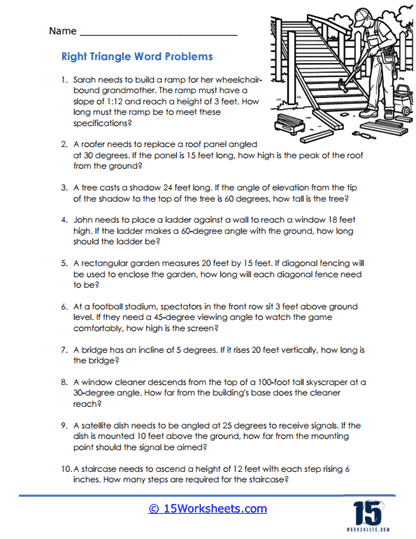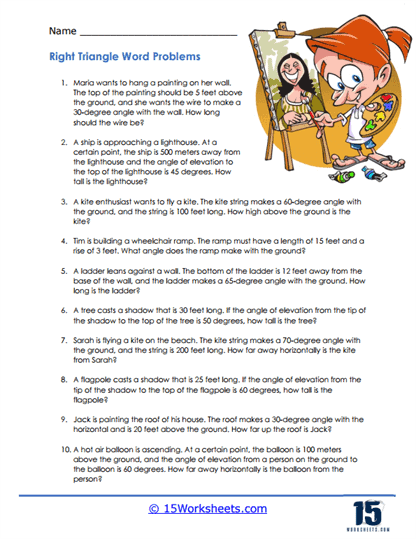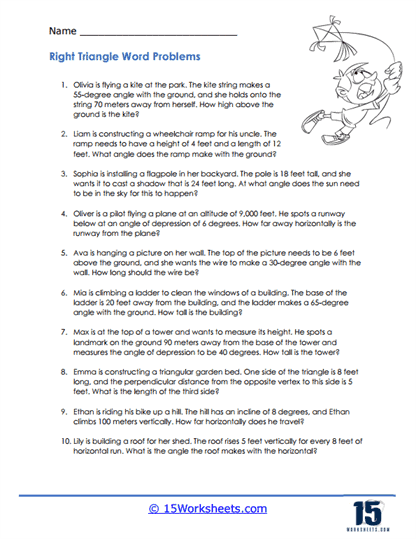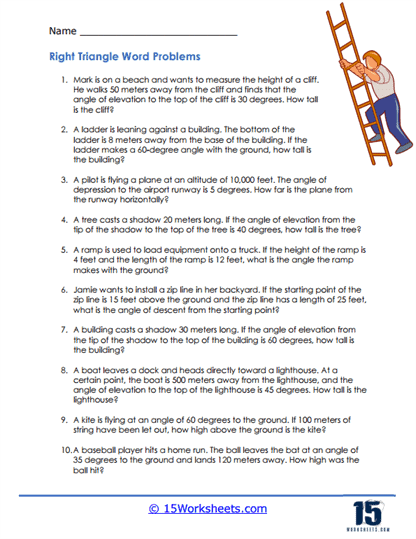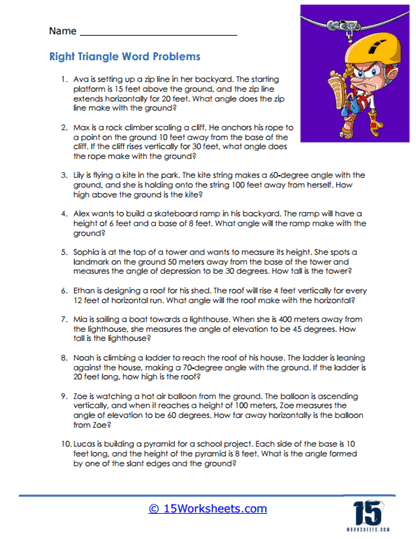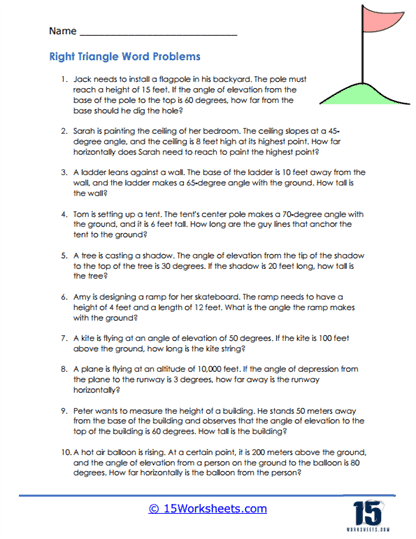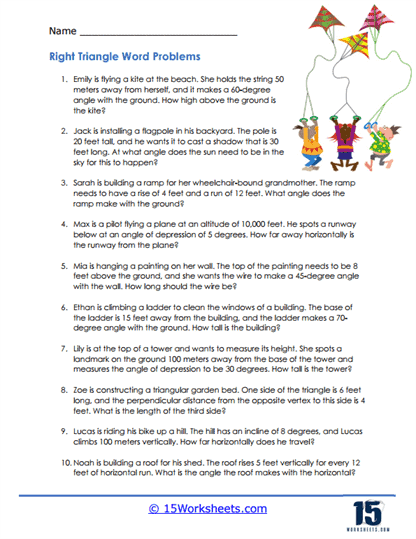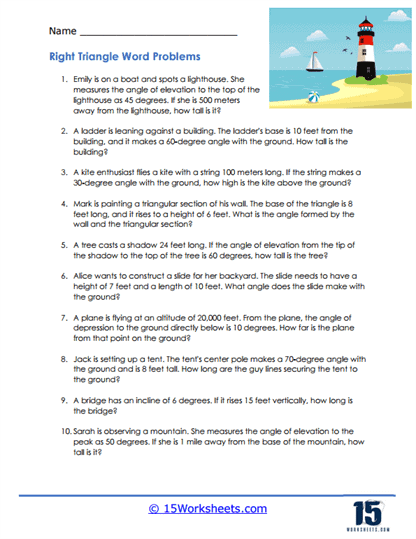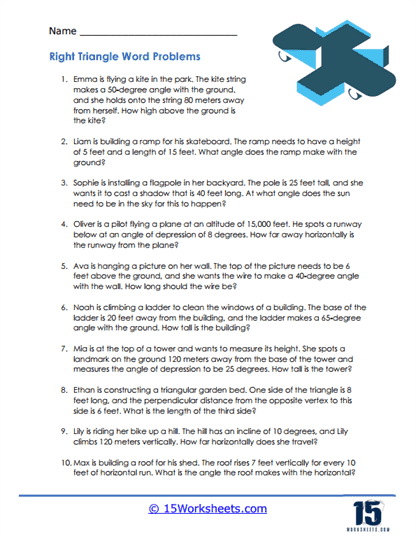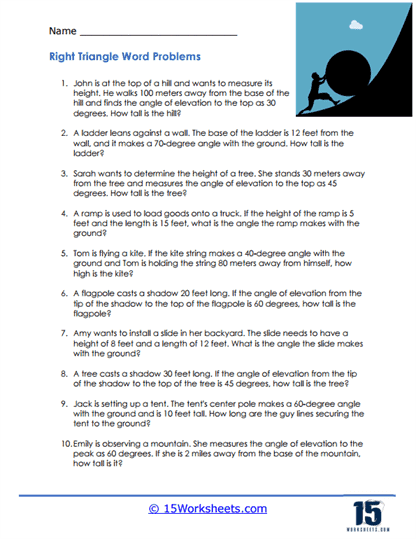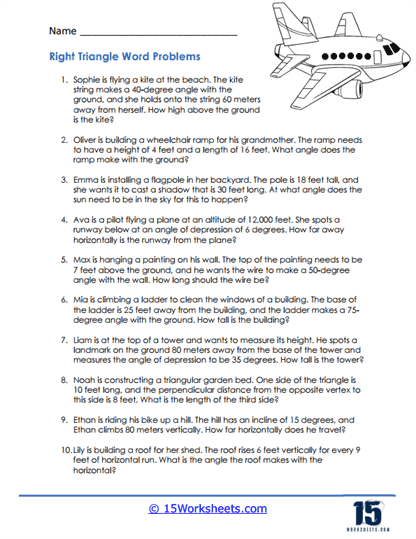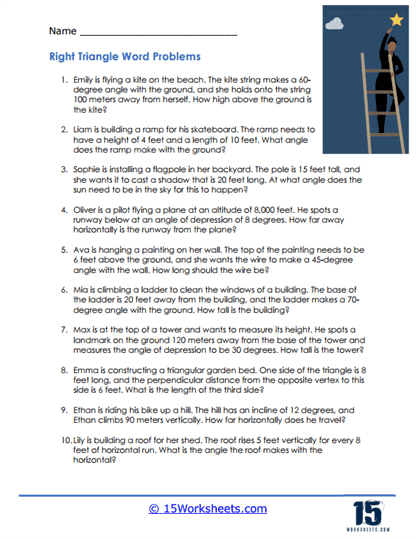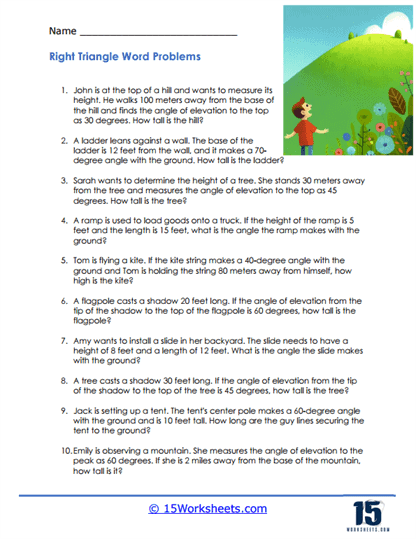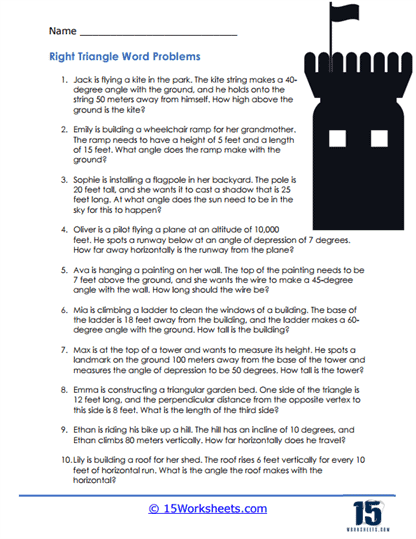Right Triangle Word Problems Worksheets
About These 15 Worksheets
These word problem worksheets can be used to help students apply their knowledge of right triangles to solve real-world problems. These worksheets typically include a variety of problems that require students to use the Pythagorean theorem and trigonometric ratios, such as sine, cosine, and tangent, to find missing side lengths or angles in right triangles. By working through these problems, students can improve their understanding of geometric principles and their ability to apply these principles in practical situations.
These worksheets include a variety of problems involving the Pythagorean theorem, trigonometric ratios, real-world measurements, and the distance formula. By practicing with these worksheets, students can improve their understanding of geometry, develop problem-solving and critical thinking skills, enhance their ability to visualize geometric concepts, and gain confidence in their mathematical abilities. Furthermore, these worksheets provide opportunities for collaborative learning and help students see the relevance of geometry in everyday life. As a result, right triangle word problem worksheets play a crucial role in students’ mathematical education, bridging the gap between theoretical knowledge and practical application.
On these sheets you will see problems that involve real-life scenarios where right triangles are present. For instance, there might be problems related to construction, where students must calculate the length of a ladder needed to reach a certain height when leaned against a wall, or problems involving navigation, where students have to determine the shortest path across a river. These scenarios help students see the relevance of right triangles beyond the classroom.
One common type of problem on these worksheets involves the Pythagorean theorem. This theorem states that in a right triangle, the square of the length of the hypotenuse (the side opposite the right angle) is equal to the sum of the squares of the lengths of the other two sides. Worksheets might present problems where students are given two side lengths and asked to find the third. For example, a problem might describe a situation where a person is walking directly north and then turns to walk directly east, forming a right triangle with their path. The worksheet would ask students to calculate the direct distance (the hypotenuse) between their starting and ending points.
Another type of problem involves the use of trigonometric ratios. These problems often require students to use sine, cosine, or tangent to find missing angles or side lengths in a right triangle. For example, a problem might describe a situation where a ramp is being built, and students need to determine the angle of elevation given the length of the ramp and the height it needs to reach. Such problems help students become familiar with using trigonometric functions and understanding their applications in measuring and constructing angles and distances.
These worksheets frequently include problems related to real-world measurements and conversions. For instance, students might be asked to calculate the height of a tree or a building using shadows and angles of elevation or depression. These problems not only reinforce their understanding of right triangles but also teach them how to apply these concepts to practical measurement tasks.
These worksheets might include problems that require the use of the distance formula, which is derived from the Pythagorean theorem. For example, students might be asked to find the distance between two points on a coordinate plane. This type of problem helps students see the connection between algebra and geometry and how right triangles can be used to solve problems involving distances in a plane.
Word problems involving right triangles also often incorporate elements of critical thinking and problem-solving. Students must not only apply mathematical formulas but also interpret the problem, identify relevant information, and sometimes make approximations or assumptions. For instance, a problem might describe a situation with incomplete information, requiring students to make reasonable estimates or infer missing data. This aspect of word problems helps develop students’ analytical skills and their ability to approach complex problems methodically.
Practicing with right triangle word problem worksheets can significantly enhance students’ understanding of geometry in the real world. These worksheets provide a context for geometric concepts, showing students how to apply theoretical knowledge to practical situations. This application helps solidify their understanding and makes abstract concepts more concrete and relatable. As students work through various problems, they become more adept at recognizing the presence of right triangles in different contexts and understanding how to use geometric principles to solve problems.
These worksheets help students develop important problem-solving skills. By tackling a variety of problems, students learn to approach each problem systematically, identifying known and unknown quantities, selecting appropriate formulas, and performing necessary calculations. This process fosters logical thinking and precision, which are valuable skills in mathematics and other disciplines.
In addition to improving problem-solving skills, right triangle word problem worksheets also enhance students’ ability to visualize geometric concepts. Many problems require students to draw diagrams or visualize the problem scenario, which helps them develop spatial awareness and an intuitive understanding of geometric relationships. This skill is particularly important in fields such as engineering, architecture, and physics, where visualizing and manipulating geometric shapes is often essential.
Practicing with these worksheets can boost students’ confidence in their mathematical abilities. As they successfully solve problems and see the practical applications of what they have learned, they gain a sense of accomplishment and become more motivated to engage with the subject. This increased confidence can have a positive impact on their overall performance in mathematics and their willingness to tackle challenging problems.
Right triangle word problem worksheets also provide opportunities for collaborative learning. Students can work together to solve problems, discuss different approaches, and share their reasoning. This collaboration can lead to a deeper understanding of geometric concepts and the development of communication and teamwork skills. Teachers can facilitate group discussions and encourage students to explain their thought processes, fostering a collaborative and supportive learning environment.
Example Problem
Ladder Problem
A 15-foot ladder is leaning against a wall. The base of the ladder is 9 feet away from the wall. How high up the wall does the ladder reach?
Solution
Step #1 – Identify the right triangle:
The ladder forms the hypotenuse of the right triangle.
The distance from the base of the ladder to the wall is one leg of the triangle.
The height up the wall that the ladder reaches is the other leg of the triangle.
Step #2 – Use the Pythagorean theorem:
a2 + b2 = c2
where c is the hypotenuse, and a and b are the legs of the triangle.
Step #3 – Plug in the known values:
c = 15 feet
a = 9 feet
Let b be the height the ladder reaches up the wall.
92 + b2 = 152
Step #4 – Calculate and solve for b.
81 + b2 = 225
b2 = 225 – 81
b2 = 144
b = √ 144
b = 12
The ladder reaches 12 feet up the wall.

